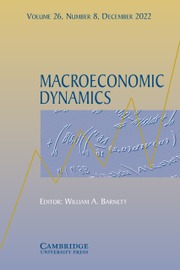No CrossRef data available.
Article contents
Wealth inequality, entrepreneurship, and aggregate output: a tale of two centuries in the UK
Published online by Cambridge University Press: 17 February 2025
Abstract
This paper investigates the long-run nexus between wealth inequality and aggregate output using a DSGE model in which wealth inequality endogenously affects individual entrepreneurship incentives, thereby influencing aggregate output. Our model passes the indirect inference test against the UK data from 1870 to 2015. We find that shocks to aggregate TFP, entrepreneurial barriers, government grant support and general government spending played significant roles in shaping historical inequality dynamics in the UK. Directly removing entrepreneurial barriers or indirectly providing government grant support to the private sector such as through inclusive loan subsidies are effective means of reducing inequality and stimulating output growth.
- Type
- Articles
- Information
- Copyright
- © The Author(s), 2025. Published by Cambridge University Press


